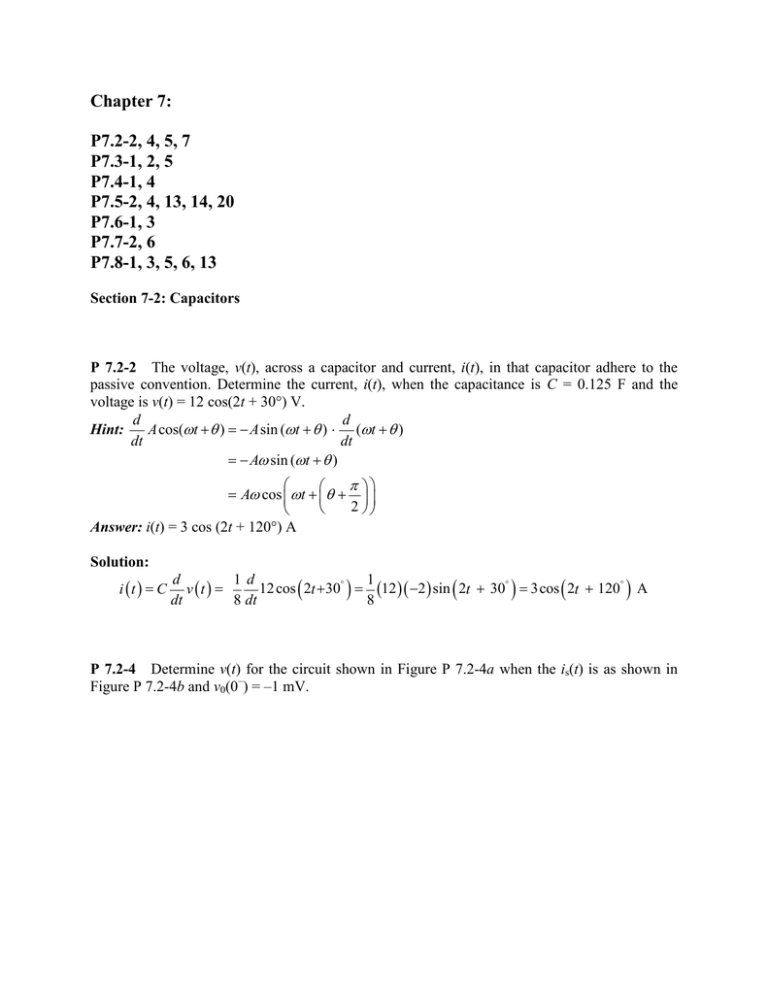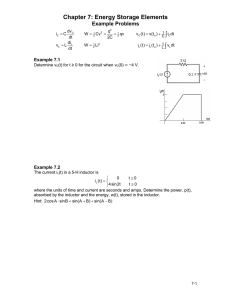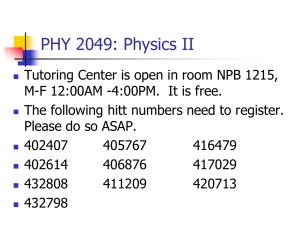Circuiti elettrici: problemi su condensatori e induttori
advertisement

Chapter 7:
P7.2-2, 4, 5, 7
P7.3-1, 2, 5
P7.4-1, 4
P7.5-2, 4, 13, 14, 20
P7.6-1, 3
P7.7-2, 6
P7.8-1, 3, 5, 6, 13
Section 7-2: Capacitors
P 7.2-2 The voltage, v(t), across a capacitor and current, i(t), in that capacitor adhere to the
passive convention. Determine the current, i(t), when the capacitance is C = 0.125 F and the
voltage is v(t) = 12 cos(2t + 30°) V.
d
d
Hint:
A cos(ωt + θ ) =
− A sin (ωt + θ ) ⋅ (ωt + θ )
dt
dt
=
− Aω sin (ωt + θ )
π
= Aω cos ωt + θ +
2
Answer: i(t) = 3 cos (2t + 120°) A
Solution:
i (t =
) C
d
v (t =
)
dt
1d
1
12 cos ( 2t +30° =
(12 )( −2 ) sin ( 2t + 30° =) 3cos ( 2t + 120° ) A
)
8 dt
8
P 7.2-4 Determine v(t) for the circuit shown in Figure P 7.2-4a when the is(t) is as shown in
Figure P 7.2-4b and v0(0–) = –1 mV.
Figure P 7.2-4
Solution:
=
v (t )
0 < t < 2 ×10−9
2 ×10−9 < t < 3 ×10−9
1 t
1
i (t ) dt +=
v ( 0)
∫
2 ×10−12
C 0
1
is ( t ) =⇒
v ( t ) = −12
0
2 ×10
t
∫ i (t ) dt − 10
t
∫ 0 dt − 10
0
−3
0
−3
=
−10−3
is ( t )= 4 ×10−6 A
t
1
4 ×10−6 ) dt − 10−3 =−5 ×10−3 + ( 2 ×106 ) t
⇒ v (t ) =
−12 ∫2ns (
2 ×10
In particular, v ( 3 ×10−9 ) =
−5 ×10−3 + ( 2 ×106 ) ( 3 ×10−9 ) =
10−3
3 ×10−9 < t < 5 ×10−9
is ( t ) =−2 ×10−6 A
t
1
−2 ×10−6 ) dt + 10−3 = 4 ×10−3 − (106 ) t
−12 ∫3ns (
2 ×10
In particular, v ( 5 ×10−9 ) =
4 ×10−3 − (106 ) ( 5 ×10−9 ) =
−10−3 V
⇒ v (t ) =
5 ×10−9 < t
1
is ( t ) =⇒
0
v ( t ) = −12
2 ×10
∫
t
5ns
−10−3 V
0 dt − 10−3 =
P 7.2-5 The voltage, v(t), and current, i(t), of a 1-F capacitor adhere to the passive convention.
Also, v(0) = 0 V and i(0) = 0 A. (a) Determine v(t) when i(t) = x(t), where x(t) is shown in Figure
P 7.2-5 and i(t) has units of A. (b) Determine i(t) when v(t) = x(t), where x(t) is shown in Figure
P 7.2-5 and v(t) has units of V.
Hint: x(t) = 4t – 4 when 1 < t < 2, and x(t) = –4t + 12 when 2 < t < 3.
Figure P 7.2-5
Solution:
0 0 < t <1
4 1< t < 2
d
=
i (t ) C=
v(t )
dt
−4 2 < t < 3
0
3<t
t
(a)
1 t
=
+
=
v (t )
i
t
d
t
v
0
)
(
)
(
∫0 i (t ) dt
C ∫0
(b)
For 0 < t < 1, i(t) = 0 A so
v=
(t )
t
+0
∫ 0 dt =
0
0V
For 1 < t < 2, i(t) = (4t − 4) A so
v ( t=
)
∫ ( 4t − 4 ) dt + =0 ( 2t
t
1
2
− 4t
( )
) 1=2 t
t
2
− 4t + 2 V
v=
(2) 2 22 − 4 ( 2 ) +
=
2 2 V . For 2 < t < 3, i(t) = (−4t + 12) A so
(
v ( t ) =∫ ( −4t + 12 ) dt + 2 = −2t 2 + 12t
t
2
( )
) 1+2= ( −2 t
t
v(3) =
−2 32 + 12 ( 3) − 14 =
4V
For 3 < t, i(t) = 0 A so v=
(t )
t
+4
∫ 0 dt =
0
4V
2
)
+ 12 t − 14 V
P 7.2-7 The voltage across a 40-μF capacitor is 25 V at t0 = 0. If the current through the
capacitor as a function of time is given by i(t) = 6e–6t mA for t < 0, find v(t) for t > 0.
Answer: v(t) = 50 – 25e–6t V
Solution:
v (t ) = v ( 0) +
1 t
4 t
=
+
×
t
t
i
d
25
2.5
10
6×10−3 ) e −6t dt
(
)
(
∫
∫
0
0
C
25 + 150 ∫ 0 e −6t dt
t
=
t
1
= 2 5 + 150 − e −6t = 50 − 25e −6t V
6
0
Section 7-3: Energy Storage in a Capacitor
P 7.3-1 The current, i, through a capacitor is shown in Figure P 7.3-1. When v(0) = 0 and C =
0.5 F, determine and plot v(t), p(t), and w(t) for 0 s < t < 6 s.
Figure P 7.3-1
Solution:
0
t<2
i=
( t ) 0.2 ( t − 2 ) 2 < t < 6
0.8
t >6
Given
The capacitor voltage is given by
v (t )
=
For t < 2
t
1 t
0
2
i
d
v
t
t
+
=
(
)
(
)
∫0 i (t ) dt + v ( 0 )
0.5 ∫ 0
=
v ( t ) 2 ∫ 0 d=
t +0 0
In particular, v ( 2 ) = 0. For 2 < t < 6
t
0
v=
0
( t ) 2 ∫ 2 (t − 2 ) dt +=
t
2
( 0.2t
2
− 0.8t=
)
t
2
( 0.2 t
2
− 0.8 t + 0.8 )=
V 0.2 ( t 2 − 4 t + 4 ) V
In particular, v ( 6 ) = 3.2 V. For 6 < t
v ( t ) = 2 ∫ 0.8 dt + 3.2 = 1.6t 2 + 3.2 =
t
t
6
(1.6 t − 6.4 ) V =
Now the power and energy are calculated as
0
2
=
p (t ) v (t =
) i ( t ) 0.04 ( t − 2 )
1.28 ( t − 4 )
t<2
2<t <6
6<t
1.6 ( t − 4 ) V
These plots were produced using three MATLAB scripts:
capvol.m
function v = CapVol(t)
if t<2
v = 0;
elseif t<6
v = 0.2*t*t - .8*t +.8;
else
v = 1.6*t - 6.4;
end
capcur.m
function i = CapCur(t)
if t<2
i=0;
elseif t<6
i=.2*t - .4;
else
i =.8;
end
c7s4p1.m
t=0:1:8;
for k=1:1:length(t)
i(k)=CapCur(k-1);
v(k)=CapVol(k-1);
p(k)=i(k)*v(k);
w(k)=0.5*v(k)*v(k);
end
plot(t,i,t,v,t,p)
text(5,3.6,'v(t), V')
text(6,1.2,'i(t), A')
text(6.9,3.4,'p(t), W')
title('Capacitor Current, Voltage and Power')
xlabel('time, s')
% plot(t,w)
% title('Energy Stored in the Capacitor, J')
% xlabel('time, s')
P 7.3-2
In a pulse power circuit the voltage of a 10-μF capacitor is zero for t < 0 and
v=
5(1 − e −4000t ) V t ≥ 0
Determine the capacitor current and the energy stored in the capacitor at t = 0 ms and t = 10 ms.
Solution:
ic ( 0 ) =
0.2 A
dv
= (10×10−6 ) ( −5 )( −4000 ) e −4000t = 0.2e −4000t A ⇒
dt
) 8.5×10−19 A
ic (10ms =
1
W ( t ) = Cv 2 ( t ) and v ( 0 ) =−
5 5e0 =0 ⇒ W ( 0 ) =
0
2
v (10×10−3 ) =−
5 5 e −40 =−
5 21.2 ×10−18 ≅ 5 ⇒ W (10 ) =
1.25×10−4 J
ic = C
P 7.3-5 A capacitor is used in the electronic flash unit of a camera. A small battery with a
constant voltage of 6 V is used to charge a capacitor with a constant current of 10 μA. How long
does it take to charge the capacitor when C = 10 μF? What is the stored energy?
Solution:
Max. charge on capacitor = C v =
60 µ C
(10×10−6 ) ( 6 ) =
60×10−6
= 6 sec to charge
10×10−6
1
1
2
W =
stored energy =
10×10−6 ) ( 6 ) =
180 µ J
C v2 =
(
2
2
∆=
t
∆q
=
i
Section 7-4: Series and Parallel Capacitors
P 7.4-1 Find the current i(t) for the circuit of Figure P 7.4-1.
Answer: i(t) = –1.2 sin 100t mA
Figure P 7.4-1
Solution:
2mmm
F 4 F=6 F
6mm
F⋅3 F
6mmm
F in series with 3 F =
=2 F
6mm
F+3 F
d
i (t ) =
2 mF
(6 cos100t ) =
(2×10−6 ) (6) (100) (− sin100t ) A =
−1.2 sin100t mA
dt
P7.4-4 The circuit shown in Figure P 7.4-4 contains seven capacitors, each having capacitance C.
The source voltage is given by
v(t ) = 4 cos(3t ) V
Find the current i(t) when C = 1 F.
Figure P 7.4-4
Solution: Replacing series and parallel capacitors by equivalent capacitors, the circuit can be
reduced as follows:
Then
8C d
8C d
8 ×1
32
i (t ) =
v (t ) =
4 cos ( 3 t ) =
− sin ( 3 t ) V
−12sin ( 3 t ) =
21 d t
21 d t
21
7
Section 7-5: Inductors
P 7.5-2 The model of an electric motor consists of a series combination of a resistor and
inductor. A current i(t) = 4te–t A flows through the series combination of a 10-Ω resistor and 0.1H inductor. Find the voltage across the combination.
Answer: v(t) = 0.4e–t + 39.6te–t V
Solution:
v= L
di
+ R i = (.1) (4e − t − 4te − t ) + 10(4te − t ) = 0.4 e − t + 39.6t e − t V
dt
P 7.5-4 The voltage, v(t), across an inductor and current, i(t), in that inductor adhere to the
passive convention. Determine the voltage, v(t), when the inductance is L = 250 mH and the
current is i(t) = 120 sin (500t – 30°) mA.
π
d
d
Hint:
+ θ ) A cos(ωt + θ ) ⋅ (ωt =
+ θ ) Aω cos(ωt =
+ θ ) Aω sin ωt + θ +
A sin(ωt =
dt
dt
2
Answer: v(t) = 15 sin(500t + 60°) V
Solution:
v(t ) = (250 ×10−3 )
P 7.5-13
d
(120 ×10−3 ) sin(500t − 30° ) = (0.25)(0.12)(500) cos(500 t − 30° )
dt
= 15 cos(500t − 30° )
The inductor current in the circuit shown in Figure P 7.5-13 is given by
i (t ) =
5 − 3e −4t A for t ≥ 0
Determine v(t) for t > 0.
Figure P 7.5-13
Solution:
We’ll write and solve a mesh equation. Label the meshes as shown. Apply KVL to the center
mesh to get
i ( t ) + 10
⇒ ia =
=
24i a + 24 ( i a − i ( t ) ) + 24 ( i a − 10 ) =
0
5 − e − 4t A for t > 0
3
24i a =
120 − 24e −4t V
v (t ) =
Then
for t > 0
(checked: LNAP 6/25/04)
P 7.5-14
The inductor current in the circuit shown in Figure P 7.5-14 is given by
i (t ) =
3 + 2e −3t A for t ≥ 0
Determine v(t) for t > 0.
Figure P 7.5-14
Solution: Apply KVL to get
d
d
v (t ) =
6i ( t ) + 5 i ( t ) =
6 ( 3 + 2e −3t ) + 5 ( 3 + 2e −3t ) =
18 (1 − e −3t ) V for t > 0
dt
dt
P7.5-20 Consider the inductor shown in Figure P7.5-20. The current
and voltage are given by
5 t − 4.6 0 ≤ t ≤ 0.2
v (t )
i ( t=
=
) a t + b 0.2 ≤ t ≤ 0.5 and
c
t ≥ 0.5
12.5 0 < t < 0.2
25 0.2 < t < 0.5
0
t > 0.5
where a, b and c are real constants. (The current is given in Amps, the
voltage in Volts and the time in seconds.) Determine the values of a, b
and c.
Answer: a = 10 A/s, b = −5.6 A and c = −0.6 A
Solution: At t = 0.2 s
Figure P7.5-20
i ( 0.2 ) =
5 ( 0.2 ) − 4.6 =
−3.6 A
For 0.2 ≤ t ≤ 0.5
i (t ) =
1 t
25 dt − 3.6 = 10t
2.5 ∫ 0.2
t
0.2
− 3.6 =
10 ( t − 0.2 ) − 3.6 = 10 t − 5.6 A
At t = 0.5 s
i ( 0.5 ) =
10 ( 0.5 ) − 5.6 =
−0.6 A
For t ≥ 0.5
1 t
i ( t ) = ∫ 0 dt − 0.6 =
−0.6
2.5 0.5
Checks:
At t = 0.2 s
i ( 0.2 ) =
10 ( 0.2 ) − 5.6 =
−3.6 A
For 0.2 ≤ t ≤ 0.5
v ( t=
) 2.5
√
d
d
i ( t=
) 2.5 (10 t − 5.6=) 2.5 (10=) 25 V √
dt
dt
−0.6 − ( −3.6
=
=
) i ( 0.5) − i ( 0.2
)
1 0.5
25=
dτ 10 ( 0.5 − 0.2
=
) 3A
2.5 ∫ 0.2
√
Section 7-6: Energy Storage in an Inductor
P 7.6-1 The current, i(t), in a 100-mH inductor connected in a telephone circuit changes
according to
t≤0
0
i (t ) 4t 0 ≤ t ≤ 1
=
4
t ≥1
where the units of time are seconds and the units of current are amperes. Determine the power,
p(t), absorbed by the inductor and the energy, w(t), stored in the inductor.
t≤0
0
0
Answer:=
p (t ) 1.6t 0 < t < 1 and
w(t ) 0.8t 2
=
0.8
t ≥1
0
The units of p(t) are W and the units of w(t) are J.
t≤0
0 < t <1
t ≥1
Solution:
v( t=) 100×10
−3
0
d
i ( t=) 0.4
dt
0
t<0
0≤ t ≤1
t>1
t <0
0
=
p ( t ) v( t=
) i( t ) 1.6t 0≤t ≤1
t >1
0
W (t )
=
P 7.6-3
∫
0
=
p (t ) dt 0.8t 2
0
0.8
t
t <0
0<t <1
t >1
The voltage, v(t), across a 25-mH inductor used in a fusion power experiment is
0
t≤0
v(t ) =
6 cos100t t ≥ 0
where the units of time are s and the units of voltage are V. The current in this inductor is zero
before the voltage changes at t = 0. Determine the power, p(t), absorbed by the inductor and the
energy, w(t), stored in the inductor. Hint: 2(cos A)(sin B) = sin(A + B) + sin(A – B)
Answer: p(t) = 7.2 sin 200t W and w(t) = 3.6[1 – cos 200t] mJ
Solution:
i (t ) =
1
25×10−3
∫
t
0
6 cos 100t dt + 0 =
6
[sin 100t | 0t ] = 2.4sin100 t
−3
(25×10 )(100)
=
p (t ) v=
(t ) i (t ) (6 cos100 t )(2.4 sin100
=
t ) 7.2 [ 2(cos100 t )(sin100 t ) ]
= 7.2 [sin 200 t +=
sin 0] 7.2 sin 200 t
t
t
7.2
cos 200t |t0
W (t ) = ∫0 p(t ) dt = 7.2 ∫0 sin 200t dt = −
200
=
0.036[1 − cos 200t ] J =
36 [1 − cos 200t ] mJ
Section 7-7: Series and Parallel Inductors
P 7.7-2 Find the voltage v(t) for the circuit of Figure P 7.7-2.
Answer: v(t) = –6e–250t mV
Figure P 7.7-2
Soluton:
(8×10 )×(8×10 )
−3
4 mH + 4 mH = 8 mH , 8mH 8mH =
−3
8×10−3 +8×10−3
= 4 mH
and 4 mH + 4 mH = 8 mH
d
v(t ) = (8×10−3 )
(5+ 3e −250t ) = (8×10−3 ) (0 + 3(−250) e −250t ) = −6 e −250t V
dt
P 7.7-6 Determine the value of the equivalent inductance, Leq, for the circuit shown in Figure P
7.7-6.
Answer: Leq = 120 H
Figure P 7.7-6
Solution:
L eq = 60 +
15 ×10
40 × 60
+ 30 +
= 60 + 6 + 30 + 24 = 120 H
15 + 10
40 + 60
Section 7-8: Initial Conditions of Switched Circuits
P 7.8-1
The switch in Figure P 7.8-1 has been open for a long time before closing at time t = 0.
Find vc(0+) and iL(0+), the values of the capacitor voltage and inductor current immediately after
the switch closes. Let vc(∞) and iL(∞) denote the values of the capacitor voltage and inductor
current after the switch has been closed for a long time. Find vc(∞) and iL(∞).
Answer: vc(0+) = 12 V, iL(0+) = 0, vc(∞) = 4 V, and iL(∞) = 1 mA
Figure P 7.8-1
Solution:
Then
+
−
i=
i=
0 and v C=
( 0+ ) v C=
( 0− ) 12 V
L (0 )
L (0 )
Next
P 7.8-3
The switch in Figure P 7.8-3 has been open for a long time before closing at time t = 0.
Find vc(0+) and iL(0+), the values of the capacitor voltage and inductor current immediately after
the switch closes. Let vc(∞) and iL(∞) denote the values of the capacitor voltage and inductor
current after the switch has been closed for a long time. Find vc(∞) and iL(∞).
Answer: vc(0+) = 0 V, iL(0+) = 0, vc(∞) = 8 V, and iL(∞) = 0.5 mA
Figure P 7.8-3
Solution:
Then
Next
+
−
i=
i=
0 and v C=
( 0+ ) v C=
( 0− ) 0 V
L (0 )
L (0 )
P7.8-5 . The switch in the circuit shown in Figure
P7.8-5 has been open for a long time before it
closes at time t = 0. Determine the values of iR(0-)
and iC(0-), the current in one of the 20 Ω resistors
and in the capacitor immediately before the switch
closes and the values of iR(0+) and iC(0+), the
current in that 20 Ω resistor and in the capacitor
immediately after the switch closes.
Figure P7.8-5
Solution:
The circuit is at steady state immediately before the switch closes. We have
The capacitor acts like an open circuit so i C ( 0 − ) =0 .
Noticing that two 20 Ω are connected in series and using
current division:
iR =
(0 −)
( 20 + 20 ) =
(120 )
20 + ( 20 + 20 )
2
120 ) 80 mA
(=
3
Using current division and Ohm’s law:
20
=
v C ( 0 ) =
(120 ) ( 20 ) 0.8 V
20 + ( 20 + 20 )
The capacitor does not change instantaneously so v C ( 0 =
+ ) v C ( 0 − ) � v C ( 0 ) . Immediately after
the switch closes we have:
Applying KVL to the loop consisting of the closed
switch, the capacitor and a 20 Ω resistor gives
0 + v C ( 0 ) − 20 i R ( 0 + ) =0
0 + 0.8
= 20 i R ( 0 + )
i R ( 0 + ) =40 mA
Applying KCL at the node at the right side of the circuit
gives:
vC (0 +)
+ i C ( 0 + ) + i R ( 0 + ) =0.120
20
0.8
+ i C ( 0 + ) + 0.04 =0.120
20
i C ( 0 +=
= 40 mA
) 0.04
Figure P7.8-6
P7.8-6. The switch in the circuit shown in Figure P7.8-6 has been open for a long time before it
closes at time t = 0. Determine the values of vL(0-), the voltage across the inductor immediately
before the switch closes and vL(0+), the voltage across the inductor immediately after the switch
closes.
Solution:
The circuit is at steady state immediately before the switch closes. We have
The inductor acts like a short circuit so v L ( 0 − ) =0
.
The inductor current is the negative of the current
source current:
i L ( 0 ) = −120 mA
The inductor current does not change instantaneously so i L ( 0 +=
) i L ( 0 − ) � i L ( 0 ) . Immediately
after the switch closes we have:
Applying KVL to the left mesh gives:
v L ( 0 + ) + 20 i L ( 0 ) =0
v L ( 0 + ) + 20 ( −0.12 ) =0
v L ( 0 + ) =2.4
P7.8-13
The circuit shown in Figure 7.8-12 has reached
steady state before the switch opens at time t = 0.
Determine the values of i L ( t ) , v C ( t ) and v R ( t )
immediately before the switch opens and the
value of v R ( t ) immediately after the switch
opens.
Answer: i L ( 0 − ) = 0.4__A, v C ( 0 − ) = 16 V,
v R ( 0 − ) = 0 V and v R ( 0 + ) = −12 V
Solution: Because
• This circuit has reached steady state
before the switch opens at time t = 0.
• The only source is a constant voltage
source.
At t=0−, the capacitor acts like an open circuit
and the inductor acts like a short circuit.
The current in the 30 Ω resistor is zero so
v R ( 0 − ) =0 V . Next
24
= 0.4 A and
20 + 40
v C (=
0 − ) 40 i L (=
0 − ) 16 V
i1 =
(0 −)
The capacitor voltage and inductor current
don’t change instantaneously so
vC (0 =
+) vC (0 =
− ) 16 V and
i L ( 0 +=
) i L ( 0 −=) 0.4 A
Apply KCL at the bottom node and then Ohm’s
law to get
v R ( 0 + ) =−30 i L ( 0 + ) =−12 V
(Notice that the resistor voltage did change instantaneously.)
Figure 7.8-13




